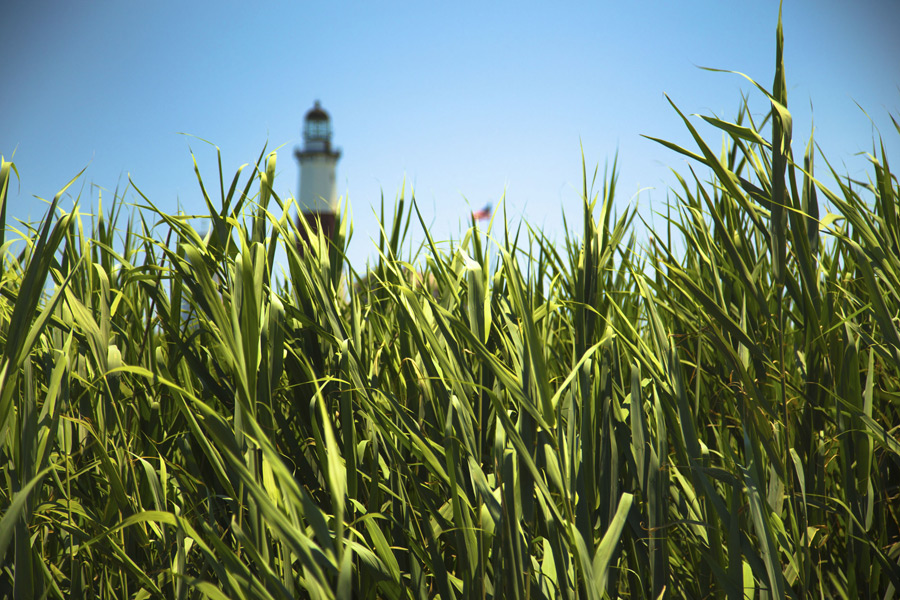Foliage: How the Barren East End Landscape Bulked Up with Greenery

I have settings on my smartphone that allow me to look up the hourly weather forecast at three different locations. They are Montauk, Bridgehampton and New York City. I am off to one or another of the three places with some frequency, and by comparing temperatures anyway, I am able to confirm, or think I am able to confirm, a popularly held belief that the temperature is several degrees hotter in the summer in New York City than in Bridgehampton, and the temperature in Montauk, with its occasional fogs from the sea, is several degrees cooler than the temperatures in Bridgehampton.
One week in mid-July it topped out at 88 in New York. Here out east it was 81. I took a Jitney out. Hot when I boarded in the city. Cool when I disembarked here.
This, of course, is just an incidental look at how things are. Last night I decided to have a good hard look at it all. It’s not too hard to do the research on this on Google. I found a way to compare apples to apples at weather.com. And I was astonished at what I saw.
The daily high temperature in the summer peaks around July 15 in all three places. In New York City the peak is 83 degrees. In Bridgehampton it is 81. But in Montauk it is also 81. It is the same thing. How can that be? New York City warmer. Bridgehampton and Montauk the same?
In Bridgehampton, the readings are taken in a barn on a farm on Lumber Lane in that town. In Montauk, the readings are taken at the Montauk Lighthouse. Have we been under the wrong impression about the variations in these high temperatures all these years? Is Montauk really not cooler than Bridgehampton?
I think that in the 1950s and 1960s when I was a lad, Montauk definitely was at least two degrees cooler than the Hamptons and at least five degrees cooler than New York City in the summertime. (It was also warmer in winter than New York. Still is, by three degrees.) You’d come down the hill in Amagansett onto the Napeague Stretch in the summer and you’d feel the sudden drop in temperature. Montauk was definitely cooler. It was also wetter and foggier. Sea breezes cooled the community. On a hot day in the Hamptons back then, I’d yearn for Montauk, and I’d go out to that town and there the cool weather would be.
The landscape of Montauk, however, has changed since I was a boy. I’ll start with Napeague. Back then, when you hit the Napeague heading east, you could see, from the road, all the way to the bay on your left and all the way to the ocean on your right. Today you don’t have those views. You have views of foliage within 20 feet of the side of the road to look at.
The same is true with Hither Hills. Years ago, the ride over the Old Montauk Highway was a thrill. You’d go up one side of those steep hills and off to your right see all the way down the cliff to the rocky beach and the ocean at the bottom. Today, trees block that view. You would hardly even know you were driving alongside the ocean.
Views throughout Montauk show the same changes. When Teddy Roosevelt and the U.S. Army set up their 20,000-man encampment in that town in 1898, you can see, in the black-and-white photos taken of all the tents, all the way to the horizon. No more. Or look at the Montauk Downs Golf Club. Originally when it was built in 1927, it was truly a “downs” in the Scottish sense—rolling hills with endless vistas. It was also that way in the 1950s and 1960s. Today it remains a beautiful course of rolling hills, but the vistas are all filled up with trees and foliage. You’d never think of it as a Scottish downs course.
Back in 1927, when Carl Fisher built the Montauk Downs Golf Club and much of the rest of that resort town, he imported trees, flowers and plants from all over the world. He had a greenhouse and tree farm for his exotica behind the Montauk Manor. He never got very far with this, but I think the re-foliation of Montauk began at that time, and later, when much landscaping began to fill the Hamptons—landscaping has become a big business—much of the pollen flew to the east and, over the years, began to grow into foliage and trees and fill in the open spaces in Montauk. That’s my theory, anyway.
Cooler temperatures can prevail on land when the winds waft over the sea to bring the lower temperatures of the salty ocean onto dry land. Landscaping cannot easily survive in salt sea air. But now, in Montauk anyway, man and his landscaping have won that war.
The peninsula of Montauk is classified by the National Weather Service with the same designation given to Block Island, Martha’s Vineyard and Nantucket. All carried the winds of salt sea air when these designations were made. (The Hamptons and the North Fork are in the same leafier designation that much of Long Island is in.)
Interestingly, the average high summer temperature on Block Island—just 12 miles off Montauk—is 78, three degrees cooler than Bridgehampton and Montauk and five degrees cooler than New York City. I would bet that in earlier days, Montauk’s temperatures were more similar to those on Block Island than those in Bridgehampton.
I confess that my approach to the questions raised here is only my own. I am no expert. And deep down, I continue to think that Bridgehampton is a bit cooler than the city and Montauk is a lot cooler than Bridgehampton. In researching this, I have come to notice there are other considerations to how we “feel” about the weather. There is humidity, the wind chill and the dew point. Factoring them in here would take a meteorologist’s expertise. I know a few. Maybe I will ask them.
Still, climates change. And it’s often the work of humans. I recall years ago that people who suffered from allergies often moved to Scottsdale, Arizona to find relief. Scottsdale was a desert. There was hardly any pollen there. That is not the case today. Wealthy retirees have filled that community with non-native flowers and shrubs and trees to such a degree that from an allergy perspective, Scottsdale is the same as everyplace else.
According to my calculations, sometime in the not-too-distant future all of the East End will have rising tides so high because of global warming that we will be little more than a series of islands—which, along with Block Island, Nantucket and Martha’s Vineyard, we will then connect up with one another via causeways to form…“The Windmill Antilles.” And we won’t be much concerned about a change in temperature of one degree or another. We’ll have other things on our minds.









